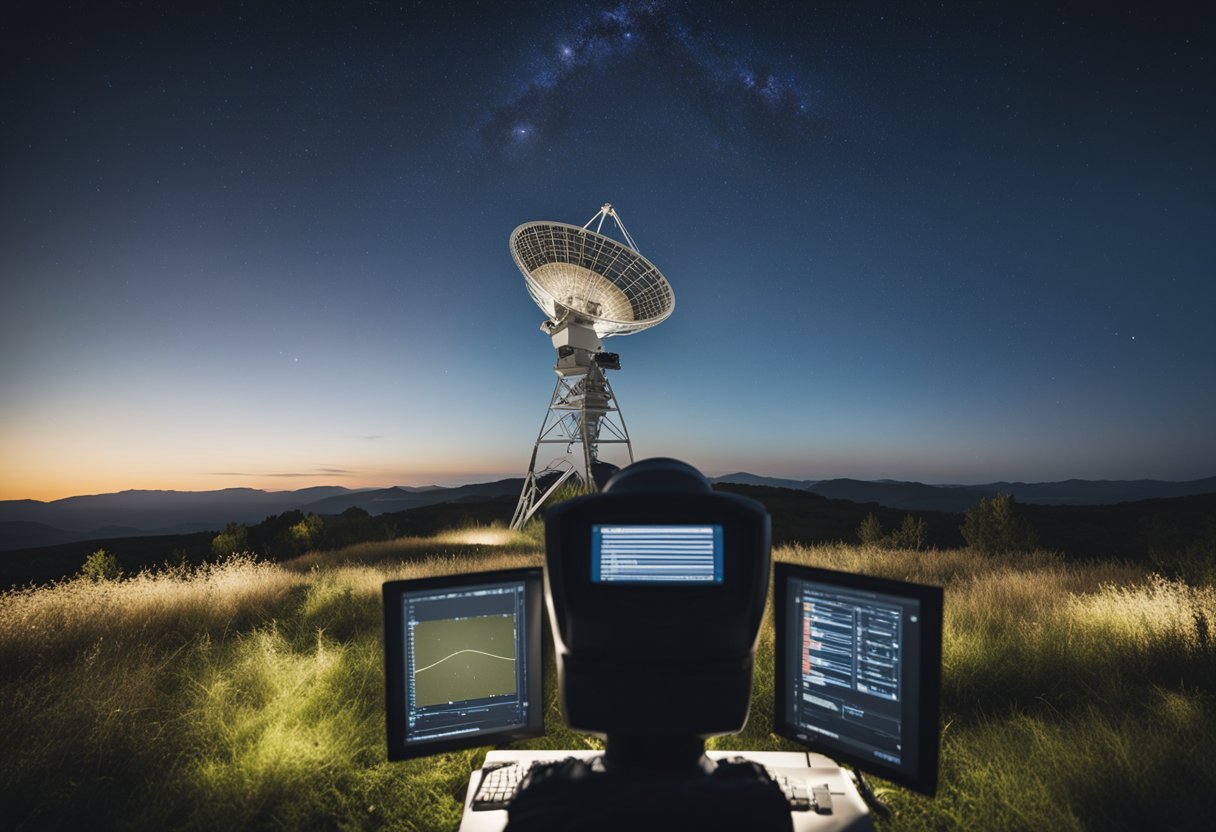
The Search for Extraterrestrial Intelligence (SETI) represents one of our most intriguing scientific endeavours, aiming to answer the age-old question: Are we alone in the universe? SETI projects harness sophisticated technologies to intercept and analyse signals that may originate from intelligent life beyond Earth. Through a historied legacy of research and technological advancement, the collective efforts of scientists across the globe have fuelled our pursuit of extraterrestrial intelligence (ETI), propelling our understanding of the cosmos and our place within it.

Our journey to uncover the secrets of the cosmos has not been without its challenges. SETI forces us to confront profound societal and philosophical questions about our existence and the potential implications of discovering other intelligent beings. Advancements in astrobiology, communication tactics, and astronomical methods play pivotal roles in driving forward the search, while educational endeavours bolster public engagement. As we peer into the depths of space, we hedge our bets on the slim chance of intercepting a signal that could redefine humanity’s perspective of life in the universe.

In this section, we’re going to explore the inception and evolution of the Search for Extraterrestrial Intelligence (SETI), a concerted scientific endeavour to detect signs of intelligent life beyond Earth through various projects and initiatives over the years.
Project Ozma, named after a character in L. Frank Baum’s Oz books, was the first attempt to detect interstellar communications from potential extraterrestrial civilisations. Pioneered by Frank Drake in 1960 at the National Radio Astronomy Observatory in Green Bank, West Virginia, USA, it marked the genesis of what would become a series of efforts to search for extraterrestrial intelligence. The project specifically targeted two nearby Sun-like stars but did not detect any signals indicative of alien life.
In 1974, the Arecibo Observatory in Puerto Rico took a proactive approach by broadcasting the first interstellar radio message towards the globular star cluster M13. This endeavour was a radical shift in strategy from passive listening to active messaging, which later evolved into what is now known as Messaging to Extraterrestrial Intelligence (METI). The Arecibo Message contained basic information about humanity and the biological life on Earth.
Throughout SETI’s history, there have been numerous projects and milestones. Perhaps the most famous signal ever received was the “Wow! signal,” a strong narrowband radio signal detected by the Big Ear radio telescope in 1977, which to date has not been repeated nor explained. Contemporary efforts like the Breakthrough Listen Project represent the most expansive search for extraterrestrial intelligence, employing advanced technologies to scan the skies for signals. Our precision and reach in scanning the cosmos for evidence of extraterrestrial life continue to grow, bolstered by innovations in radio astronomy and the ever-enlarging array of detected exoplanets.
Recent advancements in the Search for Extraterrestrial Intelligence (SETI) have led to a series of notable projects, each with unique methodologies and tools aimed at unravelling the mysteries of intelligent life beyond our planet.
The SETI Institute, a renowned non-profit organisation, has been at the forefront of extraterrestrial research. It uses the Allen Telescope Array, a collection of small satellites in northern California dedicated to scanning the cosmos for signals from other civilisations. This initiative represents a pivotal effort in utilising radio telescopes to detect frequencies that may indicate the presence of intelligent life.
The Breakthrough Listen Initiative is a significant endeavour funded by private sources to systematically search the million closest stars and the nearest 100 galaxies for extraterrestrial communications. With a duration of ten years and utilising sophisticated hardware, such as the Green Bank Telescope, it stands as one of the most comprehensive attempts at intercepting alien signals.
In the realm of citizen science, SETI@Home enables anyone with a computer to participate in the analysis of data from radio telescopes. The project leverages the distributed processing power of volunteers’ computers worldwide, analysing segments of data in the hopes of finding irregularities that might suggest non-human sources. This collective effort exemplifies how public involvement can amplify the capabilities of scientific research in our quest to uncover other intelligent beings.

In our search for intelligent life beyond Earth, we employ a range of sophisticated technologies and methodologies to detect possible extraterrestrial signals. These tools are vital for sifting through cosmic noise to find the faintest whispers of other civilisations.
Radio telescopes are the workhorses of our search, capturing radio waves from the depths of space. The size of a telescope’s dish and its signal processing capabilities are crucial; the larger the dish, the fainter the signals it can detect. The process involves scanning various frequencies, as extraterrestrial technology may emit signals across a wide spectrum. Once we receive a signal, it undergoes rigorous analysis to distinguish it from Earth-based interference and natural space noise.
One prominent example of such an instrument is the now-collapsed Arecibo Observatory, which played a significant role in the Search for extraterrestrial intelligence. Modern arrays, like the Allen Telescope Array, push the boundaries further, using multiple dishes in unison to increase sensitivity and field of view.
Conversely, Optical SETI focuses on detecting brief but powerful laser flashes that might be used by other civilisations for interstellar communication. Telescopes equipped with sensitive photometers can spot these sudden increases in brightness, which stand out against the steady glow of stars. Although this methodology is less traditional than radio detection, it offers a complementary approach. In the event that extraterrestrial technology employed laser communication, its direct and collimated nature would make it more detectable across vast interstellar distances, even with our current technology limitations.
For instance, instruments like those used in the SETI at Harvard University are probing the cosmos for such optical signals. We constantly refine our laser flash detection methods to improve our chances of discovering these potential signs of extraterrestrial technology.
In our quest to understand the universe, astrobiology plays a crucial role in searching for life beyond our planet. Through the study of exoplanets and the examination of possible biosignatures and technosignatures, we seek to uncover whether we are alone in the cosmos.
Our exploration of exoplanets—planets outside our solar system—utilises advanced telescopes and space missions. By studying these distant worlds, we aim to discern their potential to host life. Observation techniques, such as the transit method, allow us to measure an exoplanet’s size and orbit. Spectroscopy goes a step further to hint at an exoplanet’s atmospheric composition. For example, the discovery of an Earth-like planet’s atmosphere might lead us to consider its chances of habitability.
Central to astrobiology is the identification of biosignatures—indicators of past or present life. These may include molecular evidence, such as specific patterns of organic compounds, or larger-scale phenomena, such as irregularities in a planet’s atmospheric gases that biological activities could explain. The SETI Institute’s research into astrobiology emphasises the search for these life signatures.
On a larger scale, technosignatures, such as radio waves that are not of natural origin, could provide evidence of advanced civilisations. While much rarer and harder to detect, the importance of technosignatures cannot be overstated, as they could indicate the presence of technology-using life beyond Earth. This is a key aspect of the research done by astronomers and scientists who thoroughly analyse data for such anomalies.
As we continue to probe the universe, the significance of finding even a single biosignature or technosignature is immense. It would not only confirm the existence of life beyond Earth but also provide profound insights into our place in the universe.

In our quest to explore the cosmos, interstellar communication stands as a pivotal means of reaching out across the vast distances of space, potentially to connect with other intelligent life forms.
In the context of extraterrestrial interaction, we often discuss the feasibility of communicating over interstellar distances, a challenge given the immense scales involved. The concept of Active SETI, or Active Search for Extraterrestrial Intelligence, embodies the attempt to send messages to potential extraterrestrial civilisations. One well-known instance is the Arecibo message, which was transmitted in 1974 from the Arecibo Observatory. The message was a digital encoding designed to reach the globular star cluster M13, roughly 21,000 light-years away, in the hope that any civilisation therein might decode and understand it.
Fundamentally, the theories of interstellar communication consider not just the physical means of transmissions but also the complexities of language and symbolism. Given the varying conditions and unknown aspects of hypothetical extraterrestrial life, our languages and symbols may not be inherently comprehensible to them, thus requiring a language that could be universally understood — one often based on mathematics and physics, as these are considered to be universal constants.
Crafting messages for interstellar communication requires careful consideration of content, structure, and transmission methods. The composition of messages is intricate; they must be simple enough to be deciphered by non-human intelligence, yet convey sufficient sophistication to demonstrate our own. For this reason, binary code has often been used, as with the Arecibo message, embedding fundamental mathematical and physical concepts as a shared starting point.
The transmission itself poses a significant challenge, relying on powerful radio telescopes and technology capable of projecting signals across the vastness of space. As pioneers in this domain, we persist in exploring various techniques to enhance the clarity and range of our interstellar transmissions. From using radio waves to potentially more advanced methodologies, like focussing signals through the gravitational lensing of stars, we constantly strive to advance our capabilities.
The odyssey of crafting and sending these cosmic messages is not only a testament to our technological evolution but also to the inherent human desire to discover and connect with our universe’s vast and wondrous expanse.

In our quest to understand the cosmos, we employ astrophysics, exploring phenomena such as fast radio bursts (FRBs) and scrutinising the conditions that might allow planets to host life.
Fast radio bursts are intense pulses of radio waves that emerge from beyond our galaxy and last just a few milliseconds. Astrophysics has significantly benefited from the study of FRBs, as these enigmatic signals offer unique insights into the cosmos. For example, interpreting FRBs allows us to infer the distribution of matter in the universe, potentially acting as cosmic yardsticks. The mechanisms behind their origins remain a prolific area of research, and our understanding of FRBs has been advanced by analysing their frequency dispersion. This dispersion measures the delay in FRB arrival times across different frequencies and can paint a picture of their journey through intergalactic space.
Our search for habitable planets orbits around the desire to find other Earth-like worlds capable of sustaining life. Astrophysics plays a vital role in identifying planets which exist in the habitable zone of stars—regions where the temperature allows for liquid water to persist. When we consider the prospects for life existing elsewhere, planets that are similar to Earth in size, composition, and atmospheric conditions are of particular interest. Recent SETI research accentuates the ongoing efforts to understand protoplanetary disks, which directly influence moon and ring formation around planets, further illuminating the conditions that might make a planet hospitable.
By focussing on the criteria for stellar habitability, we refine our search, targeting stars that are stable and have a longevity conducive to the development of life. This intricate dance between astrophysical factors defines our approach as we continue to seek out and characterise potentially life-bearing planets across the galaxy.

Searches for Extraterrestrial Intelligence (SETI) bear significant implications for society. These explorations challenge our understanding of life, prompting us to confront profound philosophical questions, and potentially prompting a shift in international collaboration.
The detection of extraterrestrial intelligence may prompt a reevaluation of theological doctrines. Various religious communities might interpret this discovery through the lens of their beliefs, which could either reinforce or challenge traditional teachings. For instance, the Catholic Church has pondered the existence of extraterrestrial life, considering it within the context that all creation, including potential intelligent life on other planets, is part of God’s plan. Conversely, SETI’s ongoing efforts with no detection could be seen as affirmation of human uniqueness in the universe, which aligns with certain interpretations of religious texts.
Collaborations between nations are vital for SETI success. Discussions on protocols for international response to ETI detection hint at unprecedented governmental cooperation. Due to the global nature of the discovery, SETI findings would fall under the purview of international law, potentially catalysing new or strengthened intergovernmental coalitions. Such collaboration might be comparable to that within the space tourism industry, where entities like SpaceVoyageVentures.com paint the picture of nations uniting over shared aspirations.
By exploring these dimensions of SETI, we gain insight into how the pursuit of knowledge beyond our Earth impacts our societal structures, beliefs, and international politics.
SETI, or the Search for Extraterrestrial Intelligence, is an endeavour that is both fascinating and fraught with complexities. We face hurdles not only in the technical realm but also in philosophical and financial aspects of the work.
Challenges: The pursuit of extraterrestrial intelligence requires substantial financial backing and sophisticated technology. Our efforts are often limited by the availability of funds, as SETI is not always seen as a priority in the competition for scarce research monies.
Passive SETI: This approach involves listening for signals indicative of extraterrestrial technology. It’s a less intrusive method that carries minimal risk of alerting alien civilisations to our presence, yet it is still a resource-intensive operation with no guaranteed results.
Active SETI: Known as METI (Messaging to Extraterrestrial Intelligence), this proactive technique involves broadcasting signals intended for potential extraterrestrial listeners.
In both passive and active SETI, we face the enduring challenge of defining what constitutes a truly intelligent signal, designing effective communication methods, and grappling with the profound implications of potential contact.

In our quest for understanding the cosmos, we must consider the consequences of making contact and establish clear guidelines to manage any outcomes. Safety and communication are paramount in these efforts.
When engaging in activities designed to contact Extraterrestrial Intelligence (ETI), the primary concern we must address is risk management. To ensure safety, we abide by standards that limit the transmission of powerful and potentially detectable signals. These precautions are taken to prevent the unintentional invitation of unwelcome attention from advanced ETIs. The Search for Extraterrestrial Intelligence (SETI) programmers are mindful of the signals we broadcast, as highlighted by the SETI Institute’s acknowledgment of the risks associated with active messaging to ETIs (METI).
Upon the detection of an alien signal, we must follow a meticulously devised set of protocols and policies. These measures, as explained in the Revising the SETI Post-Detection Protocols, are designed to verify the signal’s authenticity and manage the ensuing communication responsibly. Our procedures include maintaining confidentiality during the signal verification process, promptly informing the public after verification, and not responding without a comprehensive international response strategy. This ensures a coordinated and cautious approach to extraterrestrial communication, safeguarding both the integrity of the research and the safety of Earth.
We recognise the significance of interaction between science and society, particularly when discussing ventures like the Search for Extraterrestrial Intelligence (SETI) which captivate the public’s imagination. Our commitment to educational outreach, coupled with the effective utilisation of media, ensures that the intricacies of SETI research and the fascination of the cosmos are accessible to all.
In our role, we have observed that educational outreach serves as an instrumental bridge between cutting-edge scientific research and classroom learning. We utilise educational programmes to instil a passion for science in students and cultivate future scientists. SETI Institute’s work is multifaceted, involving scientists dedicated to engaging with educators to develop curriculum resources that infuse astrophysics and biochemistry with the alluring question: “Are we alone in the universe?”
Through hands-on activities and interactive sessions, we spotlight the scientific method, promoting critical thinking and problem-solving skills. This proactive approach enriches the standard curriculum and contributes to a well-rounded science education, blending the curious aspects of SETI research with foundational scientific knowledge.
Our outreach programmes extend beyond the classroom, making use of various media channels to reach a broader audience. We engage in public lectures, social media updates, and even collaborate with online platforms like SpaceVoyageVentures.com, which not only documents ongoing efforts in space tourism but also delves into potential future explorations inspired by SETI findings.
We ensure that our authored articles and media contributions are factual, informative, and spark curiosity, showcasing the latest in SETI research and its implications for humanity. By being present in various forms of media, from traditional publications to modern digital outlets, we’re able to maintain a continuous dialogue with the public, enhancing their understanding of the universe and our quest to identify extraterrestrial life.

In our pursuit of understanding the cosmos and the possibility of advanced civilizations, we are on the brink of utilising even more sophisticated technologies and methods. Our focus is expanding beyond mere observation to include diverse approaches such as artificial intelligence (AI), the search for extraterrestrial artefacts, and bolstering international cooperation.
We are now incorporating the latest advancements in AI to decode the enigma of cosmic signals. AI algorithms are being trained to distinguish between irregular interstellar noise and potential communications from extraterrestrial intelligence (ETI). The use of AI not only accelerates this process but also enhances the precision with which we detect noteworthy anomalies.
Parallel to our advanced software pursuits, we have escalated the search for extraterrestrial artefacts. These endeavours are no longer confined to science fiction but are palpably shaping the future of our exploration. The emerging field of space archaeology provides systematic techniques to scrutinise planetary surfaces and space objects for potential artefacts from ETI.
Our future success in SETI is inherently tied to international cooperation. As new players emerge in the new space race, it is paramount that we unite in our efforts, sharing data and resources. Cross-border alliances will not only pool our technological capabilities but also ensure a cohesive approach towards potential first contact protocols.
In this section, we address some of the most common inquiries about the Search for Extraterrestrial Intelligence (SETI), from the signals we’ve encountered to the technologies we use and the challenges we face.
Although numerous signals have been detected by SETI projects, most have been attributed to earthly sources or natural astronomical phenomena. However, signals like the Wow! signal, detected in 1977, remain unexplained and are considered significant due to their characteristics that somewhat resemble what an extraterrestrial transmission might look like.
SETI programmes use radio telescopes to scan the cosmos for signals that are not produced by natural astrophysical processes. These telescopes are tuned to frequencies that are quiet in space yet within the bandwidth that an alien civilisation might use to communicate.
Advancements in technology anticipated to benefit SETI include more sensitive radio telescopes, the application of machine learning techniques to sift through vast amounts of data, and the deployment of spacecraft with instruments capable of detecting artificial light or laser signals.
Artificial intelligence (AI) greatly assists in analysing the massive datasets collected during SETI observations. AI algorithms can identify patterns and anomalies in the data faster and more accurately than humans, helping to pinpoint signals of interest amid cosmic noise.
SETI researchers distinguish between human-made and potential extraterrestrial signals by analysing the signal’s origin, frequency, modulation, and behaviour over time. Human-made signals often exhibit characteristics that match known terrestrial technology, while extraterrestrial signals are expected to be distinct in their consistency and signal pattern.
The primary challenges for SETI encompass both technical and financial aspects. Technically, the need for continuous advancements in sensitivity and computing power is significant, while financially, ensuring sustained funding for the wide-scale and long-duration searches necessary for success is a persistent hurdle.